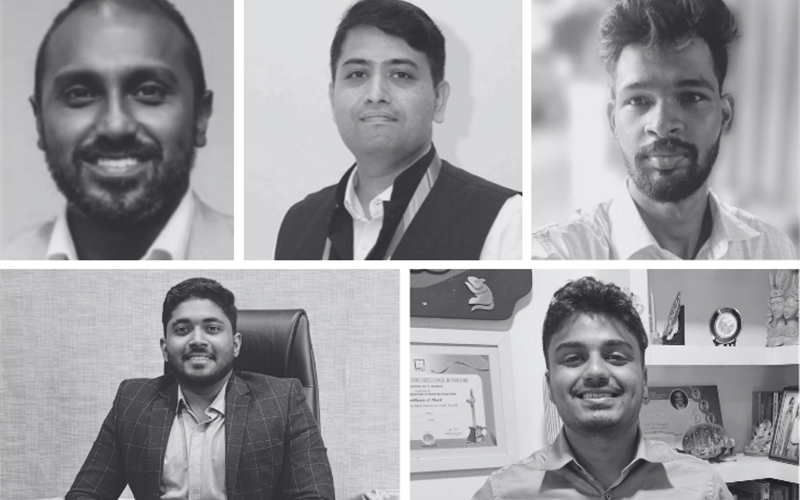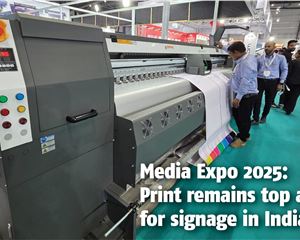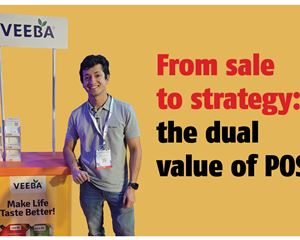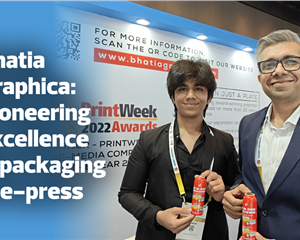How Kerala’s next-gen are driving the print agenda
During a roundtable discussion with Kerala’s next generation printers, Ramu Ramanathan engaged five industry professionals on 22 February at the Blu Radisson in Kochi. They shared their accomplishments over the last 12 months, the toughest challenges they faced in a project, and their future goals
23 Apr 2025 | By Ramu Ramanathan
Mukesh CK, Screen Pack
Ramu Ramanathan (RR): Starting with you Mukesh, one highlight in the last three months?
Mukesh CK: I joined three months ago. The good thing is, I secured five clients in three months.
RR: That’s great! And one obstacle you encountered?
Mukesh CK: I haven’t been able to develop data on time due to a shortage of machines, equipment, and manpower.
RR: What are you planning for the next 12 months?
Mukesh CK: Invest in new machines.
Kartik Nair, Sterling Print House
Kartik Nair: I just joined three weeks ago, so I’m still new to the industry. Last month, we found a new client who pays on time and orders in high volumes. This solved our cash flow struggles, this is a big relief.
RR: What challenge are you facing?
Kartik Nair: From my limited understanding, it’s getting harder to penetrate the UV printing market—especially in Kerala. We’ve invested in a UV machine. My current focus is on maximising ROI from this investment.
Anoop Venugopal, Anaswara Offset
Anoop Venugopal: Last year was very good for us, business-wise. We moved into packaging, and it marked our seventh year in the industry. Additionally, the second generation of our family has joined the business, and they are making a solid impact.
Recently, we launched a premium stationery brand called Blankverse, which is a sub-brand of Anaswara. It is gaining traction, and we are focusing on targeting youngsters and women with this brand. As part of our broader transformation, we are shifting from being purely job work printers to product creators, which is a major change in our company’s DNA.
RR: Is Blankverse available online?
Anoop Venugopal: Yes, it is available on Amazon, Instagram, and we have launched our eCommerce portal. The idea is to sell our stationery products directly through online platforms, which is a new and positive step for us.
RR: Looking ahead …
Anoop Venugopal: We are focusing more on packaging, particularly in the sustainable packaging space. Recently, we developed a unique packaging design that created a buzz in the market. It was so impactful that a major pan-India player copied our packaging design.
RR: What about sustainability?
Anoop Venugopal: We are exploring alternative materials and reducing plastic use, as customers are now more open to experimenting with eco-friendly solutions. Our goal is to push further in the sustainable packaging segment, working with paper-based and coated paper packaging solutions.
Sebastian Thomas, Print It
RR: The biggest positive for you in the last year?
Sebastian Thomas: For the past three–four years, we had our website (printitonline.in), but last year, we finally started receiving regular orders. It took a long time, but something clicked, and now we get one–two orders per day—even from cities like Mumbai, which already has many printers. This means our SEO is working well. We have another freelancing unit called The Computer Park, where freelancers can come in and work on designs.
RR: How so?
Sebastian Thomas: We focused on internal restructuring, creating systems and processes since we were transitioning from a proprietorship model.
RR: Why did it take so long for the website to take off?
Sebastian Thomas: Because we weren’t focused. We were getting 60-80 walk-ins daily, so our attention was on B2C orders, not the website. But I’ve realised that SEO takes time and consistency. The thing is, during covid, I personally built our website, and handled the SEO. Now, we have an in-house team managing it, which seems to be making a difference. Once orders started coming in, they just kept growing.
RR: What advice would you give to those struggling with their website?
Sebastian Thomas: The key thing is focus—we weren’t focused earlier. Having a dedicated in-house team for SEO made the difference.
RR: What next?
Sebastian Thomas: We are upgrading our machinery. Looking at five-colour and six-colour digital machines. We already have an embellishment system, but we want a faster one.
Amarnath MP, A-One Offset
Amarnath MP: I joined a year ago, but I had to take a break because I met with an accident. During that time, I started preparing for CAT, as I wanted to pursue an MBA. Coming to one good thing, I was able to bring in a lot of work through my personal network. People say I have good communication skills, so I leveraged that to get new clients.
RR: Such as?
Amarnath MP: We forayed into packaging three months ago, I met with Paragon early on to offer our services. Similarly, for G-Tech, we were already printing books for them, but now we are handling their packaging as well.
RR: Any interesting project?
Amarnath MP: One project is with Praise Biscuits—a brand that is gaining market share. However, we are not printing its duplex board packaging, as we need to improve our quality before taking on that responsibility.
RR: Anything else?
Amarnath MP: And one more exciting thing—we are celebrating our 25th anniversary this year!
RR: What next for you?
Amarnath MP: I have no prior experience in this industry, but my father has been mentoring me. He told me that this financial year (ending March) is crucial because it will set the benchmark for comparison with the next financial year. However, he is stepping back from active decision-making—he will still support me, but he wants me to take full responsibility for running the business. He believes that if he remains involved, he might step in to correct my mistakes, which could hinder my growth.
RR: How?
Amarnath MP: To ensure a smooth transition, he has assigned me two senior managers who have been with the company for 25 years. I don’t know whether this will be hard or easy, but I’m ready to take it on.
RR: Anoop and Sebastian, was it a similar process with you? Did your fathers mentor you in the same way, or was it totally different?
Anoop Venugopal: I joined the business in 2007. There were no special privileges for me. I was not treated as the director’s son—there was no designated seat, nothing. I had to start from the shop floor, working just like any other employee.
RR: So you had to get your hands dirty?
Anoop Venugopal: Yes, exactly. I spent three years working on the shop floor. Looking back, that was the best training I could have received. Once you go through that experience, you gain a deep understanding of what not to do. That knowledge gives me an edge today—I can sit in my seat and confidently guide my team, knowing firsthand what works and what doesn’t. The thing is, I never reported to my dad. Instead, I reported to the partners in the company. It was always a professional setting, where I had to report on daily operations.
Sebastian Thomas: I was always part of the industry. Since childhood, every summer holiday, I worked in the shop. I had early access to computers and printers, but my father always treated me like just another employee—there were no special positions, and I had zero decision-making power.
RR: When he fell ill, he started giving you more space to make decisions?
Sebastian Thomas: Yes. But he had a very different approach. He was highly optimistic and relied entirely on gut instinct. If he wanted a machine, he bought it—no SWOT analysis, no detailed planning. And somehow, he made it work. He had a loyal customer base that was always waiting to see what was next from him. He didn’t focus on marketing or sales the way we do today.
RR: Would you say that’s a reflection of the times? Things are more competitive now?
Sebastian Thomas: Absolutely. Back then, my role was simple—I had to work on the machine, give print commands, and operate just like a shop floor employee. I had no management role, no decision-making authority. I couldn’t even move a computer or shift a box without permission.
RR: When did you officially step into a leadership role?
Sebastian Thomas: I officially registered my own firm in 2014.
RR: And how different are you from your father in terms of work style?
Sebastian Thomas: He was hands-on, always meeting customers and making things happen. I’m more hands-off, focusing on building systems and processes.
RR: And your father?
Sebastian Thomas: He didn’t believe in systems—he was a great salesman and a visionary, always looking ahead. That’s something I don’t have. He could look at a machine and predict its success, whereas I rely on structured processes to ensure stability. I see myself as a caretaker of the business, while he was the creator. Those are two very different roles.
RR: Mukesh, you’ve worked in a professional setting like Monotech and seen how different printers operate. Then you came back home to the family business. How has that transition been? How much did you have to learn and unlearn?
Mukesh CK: My father and I have very different working styles. He believes in personal meetings—going out and meeting customers in person. I rely on calls and emails for customer interactions. He understands printing colours instinctively. That’s something I am trying to learn from him.
RR: But when it comes to decision-making, do you have the ability to disagree with him or say no to his decisions?
Mukesh CK: It’s tough, but I’m gradually taking on more responsibility.
RR: If you were the owner tomorrow, what would be your top priority for the business?
Mukesh CK: Automation and latest technology.
RR: How are you trying to implement that?
Mukesh CK: I’m currently building a website—it’s about 30% complete. The focus is shifting fully towards packaging. I’m also looking into virtual reality applications. Since my background is in electronics and communication engineering, I see a lot of ways to integrate tech into print.
Kartik Nair: I think my dad’s working style was very instinctive—he made decisions on a whim and uniquely handled both customers and employees. One of the biggest lessons I need to learn from him is how he built loyalty. He has helped so many people out of poverty and given them happy and stable lives. That loyalty is what drives Sterling Print every day.
RR: Sterling is like a family …
Kartik Nair: But because of that, people treat me like they treated my father—they don’t let me get my hands dirty. Instead, they say, “You just tell us what to do.” Right now, I’m just trying to be useful. It’s only been three weeks, so I don’t want to act like a boss. I’m still figuring out how I can add value.
RR: But your dad has already implemented a lot of processes and systems at Sterling?
Kartik Nair: Yes, the systems and processes are very streamlined. For me, it’s more about identifying problems and finding solutions for them. Everything else is already running smoothly.
RR: I’ve met the fathers of the other four printrepreneurs around this table, but I haven’t visited your factory yet. Would you say your father is also a larger-than-life figure in the industry?
Amarnath MP: Yes. It’s not easy to follow in the footsteps of someone who has built a strong reputation, especially in the same industry. If you venture into a completely different field, it’s a different story.
In our case, this is the third generation. My grandfather started the journey, but my father had to develop the business from the grassroots level. He was given the same freedom to make mistakes and learn from them, just like how he’s doing with me now. My grandfather let him take risks, face losses, and find his own way to grow.
RR: That must have been quite a journey. Was it a struggle for your father in the beginning?
Amarnath MP: Yes, absolutely. My mother often tells me about the struggles he faced while building the business. My grandfather was into multiple businesses—matchbox manufacturing, transport, furniture, restaurants, hollow bricks—and finally, he ventured into printing. He was dynamic because he had nothing when he started.
Back in the 1970s, he employed over 100 people. But then, due to the political situation—especially during Indira Gandhi’s emergency in the 1970s—things took a downturn, and some businesses had to shut down.
Finally, in 2000, my grandfather set up a printing business for my father. In the beginning, they made several mistakes, like investing in a brand-new machine too early, which resulted in significant losses. Recovering from that was difficult, especially since the local market at that time wasn’t very strong.
RR: That’s quite a legacy. Did you ever ask your grandfather why he chose printing, considering he was engaged in so many other industries?
Amarnath MP: I was very close to him, but I never asked him that question. I believe it was to support another business within his network. In our case, I think the business mindset was always about growth, but not just for our family—my father believes in growing together with the people around him. He invests in the development of his employees. Many of them have stayed with us for years, even when they had better salary offers elsewhere. I think it’s because they feel a sense of belonging and loyalty. My father always says that if we grow, everyone around us will grow too.
RR: That’s a wonderful philosophy. Do you think that’s influenced by the culture of North Kerala?
Amarnath MP: To some extent, yes. Kochi and Kozhikode have strong cultural values, and people appreciate stability and trust in their workplaces. But more than that, I think it’s about how my father runs the company. He ensures that everyone benefits, not just the business owner. That’s why people choose to stay.
RR: There’s a lot of work happening in Kerala right now. Are you focusing beyond the geographical limits?
Mukesh CK: No, I’m staying focused in my region. Expanding into other areas would mean competing with big players in Coimbatore, Sivakasi, and Bengaluru.
RR: That makes sense. Today, many businesses are run in a topsy-turvy manner.
Mukesh CK: Exactly. That’s the problem. I feel the middlemen are running the business like brokers, while the actual work is done by the designers. It creates a system where the people doing the work aren’t the ones benefiting from their work.
Sebastian Thomas: Manufacturing companies can grow in Kerala if they have a suitable environment to flourish. In Kerala, the print industry has potential, but there are very few manufacturers due to labour issues and strong labor unions. However, if the government provides more facilities and solutions, such as incentives for factories and manufacturers, it could encourage growth.
RR: That said, Kerala is far superior to other states. The working environment is safer, and factory spaces adhere to higher safety and health standards.
Sebastian Thomas: Yes, but that’s precisely why there are so many factories elsewhere. The regulations and strict norms in Kerala make it less profitable for manufacturers. Many would rather shift their operations to places where they can earn more.
Anoop Venugopal: Looking at Kerala’s print business, I see a volume limitation. A lot of Kerala’s print jobs are outsourced to nearby states like Tamil Nadu and Karnataka.
Even Mumbai and Delhi receive Kerala-based printing orders. So there are a lot of opportunities, and the work exists—it’s just not being retained within the state. Instead of competing for a small local market, we should identify niche opportunities, such as exports, which could bring better profitability. If we strengthen our export capabilities, we can develop a strong local industry in parallel.
RR: That’s a valid point. Kerala has plenty of printing capacity, but the bottleneck seems to be in post-press and conversion.
Anoop Venugopal: Yes, exactly. If we analyse Kerala’s binder capacity, it’s huge—at least five lakh books can be bound per day across the major players. But the challenge is converting this capacity into a profitable business.
RR: Do-able?
Anoop Venugopal: Inventory conversion needs to be faster. After covid, the commercial printing market has changed significantly. Plate consumption data shows that while the total volume of printed materials has remained steady, individual order sizes have decreased by 50%. That means more customers are printing smaller jobs, making it a double-edged sword. You gain more clients but don’t see a proportional revenue increase. To survive this shift, we need faster machinery and automation.
RR: Startups in Kerala are entering new segments. Are they leveraging these shifts to scale up?
Anoop Venugopal: There are plenty of opportunities across different sectors. The takeaway packaging segment is booming, the jewellry industry remains strong, and tourism is growing. Every sector is evolving, and it’s up to us to find ways to support them. At the end of the day, there are many ways to make money. It depends on where your passion lies.
RR: How did you venture into packaging?
Anoop Venugopal: We didn’t jump into packaging overnight. We evaluated five different business models over five years before choosing packaging. It wasn’t an easy decision, but we asked: Can we sustain this for 20 years? That’s how we made our decision—not by looking at the competition, but by ensuring that we had a long-term future in that industry.
RR: Where do you see yourself in 2050?
Mukesh CK: My dream is to create employment opportunities and empower people, at least more than 1,000 individuals. That is my vision.
Amarnath MP: Since we are seeing volume declines, I think B2C expansion is necessary. We should diversify into B2C while maintaining B2B.
RR: So, you’re saying bigger companies and brands are cutting down on print volumes?
Amarnath MP: Yes. Even with large companies like Reliance, where we have a vendor code, their print volume has been cut down by 50% in recent years. When we asked why, they said it’s part of cost-cutting. The first thing they cut? Printing. That’s a major issue in this industry. It’s tough, but we’ve adapted.
Kartik Nair: Honestly, predicting the future is like science fiction. We could never have predicted covid. We didn’t anticipate the floods. If everything stays stable, then yes, we can plan. But 15 years ago, we were just printing magazines and brochures—we never thought brochures would become obsolete. So, 15 years from now, who knows what new consumer mindset shifts will happen?
RR: Come on, that’s no answer. Please give me one safe answer …
Kartik Nair: We want to be flexible enough to serve whatever the market demands.
RR: And one not-so-safe answer?
Kartik Nair: As you know, I am a musician and DJ; so I wish for Sterling to be as big as Coldplay in 2050.
Biggest challenge in Kerala
Anoop Venugopal: One major challenge has been manpower. After covid, many new markets have opened up, leading to a migration of skilled workers from Kerala to overseas markets like Eastern Europe and Croatia, apart from Dubai. For instance, just yesterday, one of our long-standing staff members left for Croatia. We did not anticipate this shift, and it has been challenging to manage operations, especially on the machine side.
Sebastian Thomas: Retaining trained manpower is a massive challenge. When we train people, they leave too soon, often before they are fully skilled. In Kerala, hiring is happening without background checks—companies are desperate for workers. For example, someone working with us for INR 15,000 for four months gets hired elsewhere for INR 20,000, even though they aren’t fully trained. This creates a negative cycle—it disrupts the ecosystem, increases dissatisfaction, and hurts the industry as a whole.
Amarnath MP: Honestly, I haven’t faced any major challenges yet. Staff retention is not a problem for us, 90-95% of our workers have been with us for over 20 years. Unlike other companies, we don’t have an issue with employees leaving for better opportunities elsewhere.












 See All
See All